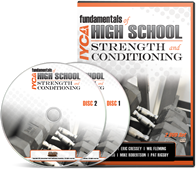High School Athletes

b) Learning Exploration (10 – 13)
- Very similar in terms of primarily Outcome-Based (roughly 80%) and explorative in nature. In this phase, due to increased Training, Biological and Emotional ages however, we can add points of quantified instruction. The CNS is still very plastic and therefore adaptable to change – what we become fluent in while young, we retain forever.
- Exploration type activities (games, skills etc) are more formalized and advanced. What was a simple 180-degree jump and land, now is a 180-jump and land with transition to back pedal jog. Adding complexity to movement sequences will increase the warehousing of neural/athletic ability.
- Teach complex, multi-joint movements in a skill set fashion (4 points that guide young high school athletes from set-up to execution. ‘Squat’, for example:
- Set Your Feet
- Eyes Up
- Hips Back
- In-Steps Off
Additionally, create progressive ‘add-ons’ to skill by teaching in a systematic way. For example, teach ‘Lateral Deceleration’ through a 4-part method that builds layers of skill along the process of becoming proficient:
-
- Repeat Statically – in place
- Repeat Dynamically – predictable, unspecific, with cadence locomotion
- Repeat Randomly – unpredictable, unspecific, with cadence locomotion
- Repeat Chaotically – unpredictable, specific, with full-speed locomotion

c) Train With Application (14+)
- Form-Based coaching is essential; implying that technical adherence and proficiency is required.
- Create ‘Templates’ with associated time allotments so that all training sessions are harmonious, provide individual instructive capacity within group settings and allow you to assess for, detect and scale weaknesses making them more of a priority. For example:
- Tissue Quality (5 – 8 minutes)
- ROM/Mobility (5 – 8 minutes)
- Torso (5 – 8 minutes)
- Movement Prep (5 – 8 minutes)
- Movement Instruction/Execution (12 – 15 minutes)
- Strength Instruction (5 – 8 minutes)
- Strength/Power Execution (12 – 15 minutes)
- Tissue Quality/Active Flexibility (5 – 8 minutes)
Tomorrow, I’ll finish off with ‘Part 3’…
… Why I think you may not be doing a good enough job training young people…
– Brian
P.S. – Absolutely Everything You’d Ever Need to Know About Training High School Athletes… And the Most Important Credentials in the World:
Click Here —> https://iyca.org/highschool/



EXCELLENT
Very well organized to every details
Very informative and helps all coaches understand that the young athlete 10 – 13 and 14+ cannot be trained like a seasoned adult athlete.
Very applicable material that can be used immediately with you athletes.
I want to know more about the High School Program. Any video showing what you are doing in weight, agility, and speed programs?
We need a big change in our girls athletic program – feel we are falling behind with other programs . Age/grades we work with 9th – 12th, all sports.
Thanks
Hi Woody,
You can find more information about the IYCA High School Strength & Conditioning Coach Certification here:
http://iyca.org/dev/highschool/
Otherwise, if you have specific questions, feel free to send them to us at support@iycasupport.com
Have a great week,
Sara Beth